| Gogo Formation | |
|---|---|
| Stratigraphic range: Frasnian PreꞒ Ꞓ O S D C P T J K Pg N | |
| Type | Geological formation |
| Underlies | Virgin Hills Formation |
| Overlies | Unconformity with Prices Creek Group |
| Thickness | Up to 700 m (2,300 ft) |
| Lithology | |
| Primary | Shale, Siltstone |
| Other | Limestone |
| Location | |
| Location | Kimberley, Western Australia |
| Coordinates | 18°18′S 126°30′E / 18.3°S 126.5°E / -18.3; 126.5 |
| Approximate paleocoordinates | 16°42′S 136°42′E / 16.7°S 136.7°E / -16.7; 136.7 |
| Region | Western Australia |
| Country | |
| Type section | |
| Named for | Gogo Station |
| Thickness at type section | ~425 m (1,394 ft) |
 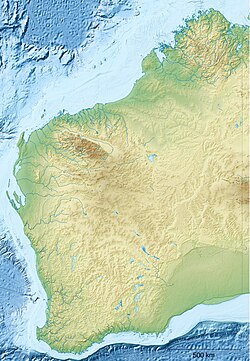 | |
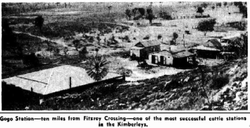
The Gogo Formation in the Kimberley region of Western Australia is a Lagerstätte that exhibits exceptional preservation of a Devonian reef community. The formation is named after Gogo Station, a cattle station where outcrops appear and fossils are often collected from, as is nearby Fossil Downs Station.
History
The reef, which now stands up abruptly in the western Australian desert (as the Windjana Limestone), was first identified in 1940 by paleontologist Curt Teichert, who discovered the first fossil fish from the region.
Sedimentology
Unweathered sections of the Gogo Formation are made of siltstone, shale and calcarenite with numerous limestone concretions. These concretions are resistant to weathering, producing extensive nodule fields on the ground in areas where the surrounding rock has eroded away.
The Gogo sediments represent deep, hypoxic seafloor deposits in the vicinity of a large tropical reef composed primarily of algae and stromatoporoids during the Frasnian faunal stage of the Late Devonian. Associated stratigraphic units which comprise this ancient reef system are the Windjana Formation (the actual reef structures), Pillara Limestone (reef platform) and the Sadler Formation (fore-reef deposits).
Deposition
The formation was deposited in the Frasnian (late Devonian).
Fossil preservation
The fossils of the Gogo Formation display three-dimensional soft-tissue preservation of tissues as fragile as nerves and embryos with umbilical cords. Over fifty species of fish have been described from the formation, and arthropods, including phyllocarids and eurypterids are similarly well-preserved. Nautiloids, goniatites and tentaculids are also known from the formation, but their soft tissue is not preserved.
The calcareous concretions formed around objects from the shallow reef areas which sank into the deep anoxic basins. The concretions sometimes contain the remains of fish, whose bodies are often preserved complete in three-dimensions due to rapid encasement and the slow rate of decay in the oxygen-poor surroundings. By repeated baths in a dilute acid solution, the matrix is dissolved away via a process of acid etching to reveal delicate fish fossils, some retaining impressions of soft tissues.
The discovery of Materpiscis, a placoderm preserved with an embryonic juvenile still attached by its umbilical cord, has revealed that at least some placoderms gave birth to live young.
Fossil content
Placodermi
| Genus | Species | Notes | Images |
|---|---|---|---|
| Austroptyctodus | A. gardinieri | ||
| Bothriolepis | Indeterminate |  | |
| Bruntonichthys | B. multidens |  | |
| Bullerichthys | B. fascidens | ||
| Campbellodus | C. decipiens | 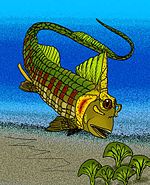 | |
| Camuropiscis | C. concinnus |  | |
| C. laidlawi | |||
| Compagopiscis | C. croucheri |  | |
| Eastmanosteus | E. calliaspis |  | |
| Fallacosteus | F. turneri |  | |
| Harrytoombsia | H. elegans |  | |
| Holonema | H. westolli | 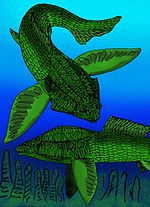 | |
| Incisoscutum | I. ritchei |  | |
| I. sarahae | |||
| Kendrickichthys | K. cavernosus | ||
| Kimberleyichthys | K. bispicatus | ||
| K. whybrowi | |||
| Materpiscis | M. attenboroughi |  | |
| Latocamurus | L. coulthardi | 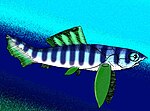 | |
| Mcnamaraspis | M. kaprios |  | |
| Pinguosteus | P. thulborni |  | |
| Rolfosteus | R. canningensis |  | |
| Simosteus | S. tuberculatus |  | |
| Torosteus | T. tuberculatus | ||
| T. pulchellus | |||
| Tubonasus | T. lennardensis |  |
Actinopterygii
| Genus | Species | Notes | Images |
|---|---|---|---|
| Gogosardina | G. coatesi | ||
| Mimipiscis | M. toombsi |  | |
| Moythomasia | M. durgaringa |  | |
| M. lineata |
Chondrichthyes
| Genus | Species | Notes | Images |
|---|---|---|---|
| Gogoselachus | G. lynbeazleyae |  |
Acanthodians
| Genus | Species | Notes |
|---|---|---|
| Halimacanthodes | H. ahlbergi |
Sarcopterygii
| Genus | Species | Notes | Images |
|---|---|---|---|
| Adololopas | A. moyasmithae | ||
| Chirodipterus | C. australis | ||
| Ngamugawi | N. wirngarri | Originally considered as Diplocercides. | |
| Gogodipterus | G. paddyensis | ||
| Gogonasus | G. andrewsae |  | |
| Griphognathus | G. whitei | ||
| Holodipterus | "H" (Holodipteroides) elderae | ||
| H. gogoensis | |||
| H. meemanae | |||
| Onychodus | O. jandemarrai |  | |
| Pillararhynchus | P. longi | ||
| Rhinodipterus | R. kimberleyensis | ||
| Robinsondipterus | R. longi | ||
| Xeradipterus | X. hatcheri |
Conodonta
| Genus | Species | Notes |
|---|---|---|
| Polygnathus | P. varca | |
| P. normalis | ||
| P. asymmetrica asymmetrica | ||
| P. asymmetrica ovalis | ||
| Playfordia | P. primitiva | |
| Gnamptognathus | G.? lipperti | |
| G.? cf. G.? lipperti | ||
| Ancyrodella | A. rotundiloba alata | |
| A. rotundiloba rotundiloba | ||
| Icirodus | I. symmetricus | |
| Roundya | A. aurita |
Ammonoidea
| Genus | Species | Notes |
|---|---|---|
| Timanites | T. angustus | |
| Tornoceras | T. (T.) simplex |
Arthropoda
| Genus | Species | Notes | Images |
|---|---|---|---|
| Montecaris | M. gogoensis | Phyllocarid arthropod, reaching length up to 60 centimetres (24 in). |  |
| M. sp. indet. | |||
| Schugurocaris | S. wami | Phyllocarid arthropod. | |
| S. sp. indet. | |||
| Dithyrocaris | D. sp. indet. | ||
| Concavicaris | C. campi | Thylacocephalan arthropod. | |
| C. glenisteri | |||
| C. milesi | |||
| C. playfordi | |||
| C. sp. | |||
| Harrycaris | H. whittingtoni | ||
| Adelophthalmus | A. waterstoni | An eurypterid. Originally described as a species of Rhenopterus. |  |
| Undescribed eurypterid | |||
| 'Mushia' | Common fossil from Gogo Formation, undescribed arthropod with unknown affinity. Chemical analysis shows that is likely to be a crustacean. |
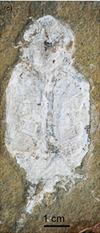 |
References
- "The Fossil Emblem of Western Australia" Archived 22 May 2016 at the Wayback Machine Accessed 16 August 2012.
- Long, John (2007). Swimming in Stone: the Amazing Gogo Fossils of the Kimberley. Fremantle, W.A.: Fremantle Arts Centre.
- ^ "Australian Stratigraphic Names Database". Australian Government Geoscience Australia. 29 September 2010. Retrieved 28 March 2011.
- "Gogo Reef Formation". Archived from the original on 7 March 2018. Retrieved 28 May 2008.
- ^ Long, J. A.; Trinajstic, K. (2010). "The Late Devonian Gogo Formation Lägerstatte of Western Australia: Exceptional Early Vertebrate Preservation and Diversity". Annual Review of Earth and Planetary Sciences. 38: 255–279. Bibcode:2010AREPS..38..255L. doi:10.1146/annurev-earth-040809-152416.
- ^ Ian Rolfe, W. D. (1966). "Phyllocarid Crustacean Fauna of European Aspect from the Devonian of Western Australia". Nature. 209 (5019): 192. Bibcode:1966Natur.209..192R. doi:10.1038/209192a0. S2CID 129316791.
- Tetlie, O. E.; Braddy, S. J.; Butler, P. D.; Briggs, D. E. G. (2004). "A New Eurypterid (Chelicerata: Eurypterida) from the Upper Devonian Gogo Formation of Western Australia, with a Review of the Rhenopteridae". Palaeontology. 47 (4): 801. Bibcode:2004Palgy..47..801T. doi:10.1111/j.0031-0239.2004.00390.x.
- "Aussie fish fossil gives birth to history" Accessed 29 May 2008.
- ^ Long, J.A. 1997. Ptyctodontid fishes (Vertebrata, Placodermi) from the Late Devonian Gogo Formation, Western Australia, with a revision of the European genus Ctenurella Orvig, 1960. Geodiversitas 19(3): 515–555.
- Patten, W. (July 1904). "New facts concerning Bothriolepis". Biological Bulletin. 7 (2): 113–124. doi:10.2307/1535537. JSTOR 1535537.
- ^ DENNIS, K. and MILES, R. S. (1980), New durophagous arthrodires from Gogo, Western Australia. Zoological Journal of the Linnean Society, 69: 43–85. doi:10.1111/j.1096-3642.1980.tb01932.x
- Dennis, Kim; R. S. Miles (September 1979). "A second eubrachythoracid arthrodire from Gogo, Western Australia". Zoological Journal of the Linnean Society. 67: 1–29. doi:10.1111/j.1096-3642.1979.tb01102.x.
- Locality No. 20, Stromatoporoid Camp Area at Fossilworks.org
- ^ Sallan, Lauren Cole; Coates, Michael I. (1 June 2010). "End-Devonian extinction and a bottleneck in the early evolution of modern jawed vertebrates". Proceedings of the National Academy of Sciences. 107 (22): 10131–10135. Bibcode:2010PNAS..10710131S. doi:10.1073/pnas.0914000107. ISSN 0027-8424. PMC 2890420. PMID 20479258.
- Dennis-Bryan, K. (1987). "A new species of eastmanosteid arthrodire (Pisces: Placodermi) from Gogo, Western Australia". Zoological Journal of the Linnean Society. 90 (1): 1–64. doi:10.1111/j.1096-3642.1987.tb01347.x.
- ^ Long, J. A. 1990a, "Two new arthrodires (placoderm fishes) from the Upper Devonian Gogo Formation, Western Australia", Memoirs of the Queensland Museum 28, De Vis Symposium Volume, pp. 51–64.
- "Fossilworks: Harrytoombsia". fossilworks.org.
- Denison, Robert (1978). Placodermi Volume 2 of Handbook of Paleoichthyology'. Stuttgart New York: Gustav Fischer Verlag. p. 63. ISBN 978-0-89574-027-4
- J. A. Long. 1994. A second incisoscutid arthrodire (Pisces, Placodermi) from the Late Devonian Gogo Formation, Western Australia. Alcheringa 18(1-2):59-69
- Long, J. A.; Trinajstic, K.; Young, G. C.; Senden, T. (2008). "Live birth in the Devonian period". Nature. 453 (7195): 650–652. Bibcode:2008Natur.453..650L. doi:10.1038/nature06966. PMID 18509443. S2CID 205213348.
- Long, J. A. (1988). "A new camuropiscid arthrodire (Pisces: Placodermi) from Gogo, Western Australia". Zoological Journal of the Linnean Society. 94 (3): 233–258. doi:10.1111/j.1096-3642.1988.tb01194.x.
- Long, J. (1995). "A new ploudosteid arthrodire from the Upper Devonian Gogo Formation of Western Australia". Palaeontology. 38: 39–62.
- ^ Dennis, K.; Miles, R. S. (1979). "Eubrachythoracid arthrodires with tubular rostra1 plates from Gogo, Western Australia". Zoological Journal of the Linnean Society. 67 (4): 297–328. doi:10.1111/j.1096-3642.1979.tb01118.x.
- Dennis, K.; Miles, R. S. (1982). "A eubrachythoracid arthrodire with a snubnose from Gogo, Western Australia". Zoological Journal of the Linnean Society. 75 (2): 153–166. doi:10.1111/j.1096-3642.1982.tb01945.x.
- Choo, Brian (2012). "Revision of the actinopterygian genus Mimipiscis (=Mimia) from the Upper Devonian Gogo Formation of Western Australia and the interrelationships of the early Actinopterygii". Earth and Environmental Science Transactions of the Royal Society of Edinburgh. 102 (2): 77–104. Bibcode:2012EESTR.102...77C. doi:10.1017/s1755691011011029. hdl:1885/59192. S2CID 129324004. Retrieved 29 March 2012.
- Long, John A.; Burrow, Carole J.; Ginter, Michal; Maisey, John G.; Trinajstic, Kate M.; Coates, Michael I.; Young, Gavin C.; Senden, Tim J. (28 May 2015). "First Shark from the Late Devonian (Frasnian) Gogo Formation, Western Australia Sheds New Light on the Development of Tessellated Calcified Cartilage". PLOS ONE. 10 (5): e0126066. Bibcode:2015PLoSO..1026066L. doi:10.1371/journal.pone.0126066. ISSN 1932-6203. PMC 4447464. PMID 26020788.
- Burrow, Carole J.; Trinajstic, Kate; Long, John (1 August 2012). "First acanthodian from the Upper Devonian (Frasnian) Gogo Formation, Western Australia". Historical Biology. 24 (4): 349–357. Bibcode:2012HBio...24..349B. doi:10.1080/08912963.2012.660150. ISSN 0891-2963. S2CID 128481092.
- ^ Miles, R. S. (1977). "Dipnoan (lungfish) skulls and the relationships of the group: a study based on new species from the Devonian of Australia". Zoological Journal of the Linnean Society. 61 (1–3): 1–328. doi:10.1111/j.1096-3642.1977.tb01031.x. ISSN 0024-4082.
- LONG, J.A. & TRINAJSTIC, K. 2010. The Late Devonian Gogo Formation Lagerstatte –Exceptional preservation and Diversity in early Vertebrates. Annual Review of Earth and Planetary Sciences 38: 665-680
- Clement, Alice M.; Cloutier, Richard; Lee, Michael S. Y.; King, Benedict; Vanhaesebroucke, Olivia; Bradshaw, Corey J. A.; Dutel, Hugo; Trinajstic, Kate; Long, John A. (12 September 2024). "A Late Devonian coelacanth reconfigures actinistian phylogeny, disparity, and evolutionary dynamics". Nature Communications. 15 (1): 7529. doi:10.1038/s41467-024-51238-4. ISSN 2041-1723. PMC 11392942.
- Long, John A. (1992). "Gogodipterus paddyensis (Miles), gen. nov., a new chirodipterid lungfish from the late Devonian Gogo formation, Western Australia". The Beagle: Occasional Papers of the Northern Territory Museum of Arts and Sciences. 9: 11–20.
- Long, J. A. (1985). "A new osteolepidid fish from the Upper Devonian Gogo Formation of Western Australia". Recs. W. A. Mus. 12 (8): 361–377.
- Andrews, Mahala; Long, John; Ahlberg, Per; Barwick, Richard; Campbell, Ken (2006). "The structure of the sarcopterygian Onychodus jandemarrai n. sp. from Gogo, Western Australia: with a functional interpretation of the skeleton". Transactions of the Royal Society of Edinburgh. 96 (3): 197–307. doi:10.1017/s0263593300001309. S2CID 84910707 – via ResearchGate.
- "A Late Devonian dipnoan, Pillararhynchus, from Gogo, Western Australia, and its relationships". ResearchGate. Retrieved 3 June 2019.
- John A. Long 2010. New holodontid lungfishes from the Upper Devonian Gogo Formation of Western Australia. Pp. 275-298 in: Elliott, D.K., Maisey, J.G., Yu, X. & Miao, D. (eds): Morphology, Phylogeny and Paleobiogeography of Fossil Fishes. Verlag Dr. Friedrich Pfeil, München.
- Alice M. Clement & John A. Long (2010). "Xeradipterus hatcheri, a new dipnoan from the Late Devonian (Frasnian) Gogo Formation, Western Australia, and other new holodontid material". Journal of Vertebrate Paleontology. 30 (3): 681–695. Bibcode:2010JVPal..30..681C. doi:10.1080/02724631003763482. S2CID 83739846.
- ^ Glenister, Brian F.; Klapper, Gilbert (1966). "Upper Devonian Conodonts from the Canning Basin, Western Australia". Journal of Paleontology. 40 (4): 777–842. ISSN 0022-3360. JSTOR 1301879.
- ^ Briggs, Derek E. G.; Rolfe, W. D. Ian; Butler, Piers D.; Liston, Jeff J.; Ingham, J. Keith (1 September 2011). "Phyllocarid crustaceans from the Upper Devonian Gogo Formation, Western Australia". Journal of Systematic Palaeontology. 9 (3): 399–424. Bibcode:2011JSPal...9..399B. doi:10.1080/14772019.2010.493050. ISSN 1477-2019. S2CID 84353143.
- "CATALOGUE OF TYPE FOSSILS IN THE WESTERN AUSTRALIAN MUSEUM | Western Australian Museum". museum.wa.gov.au. Retrieved 5 July 2023.
- Bicknell, Russell D. C.; Smith, Patrick M.; Poschmann, Markus (1 October 2020). "Re-evaluating evidence of Australian eurypterids". Gondwana Research. 86: 164–181. Bibcode:2020GondR..86..164B. doi:10.1016/j.gr.2020.06.002. ISSN 1342-937X. S2CID 225748023.
- ^ Trinajstic, Kate; Briggs, Derek E. G.; Long, John A. (23 November 2021). "The Gogo Formation Lagerstätte: a view of Australia's first great barrier reef". Journal of the Geological Society. 179 (1). doi:10.1144/jgs2021-105. ISSN 0016-7649. S2CID 243284735.
- Geologic formations of Australia
- Devonian System of Australia
- Devonian southern paleotropical deposits
- Frasnian Stage
- Limestone formations
- Shale formations
- Reef deposits
- Devonian southern paleotemperate deposits
- Lagerstätten
- Fossiliferous stratigraphic units of Oceania
- Paleontology in Australia
- Geology of Western Australia
- Devonian Australia

